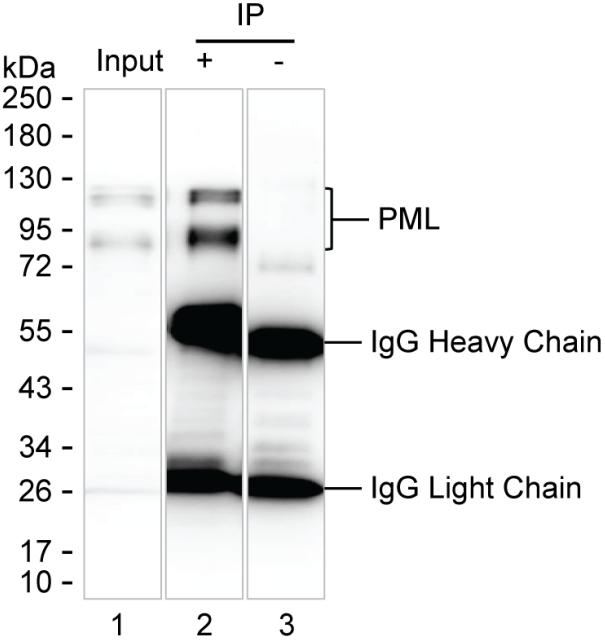
| WB | 咨询技术 | Human,Mouse,Rat |
| IF | 1/100-1/200 | Human,Mouse,Rat |
| IHC | 咨询技术 | Human,Mouse,Rat |
| ICC | 技术咨询 | Human,Mouse,Rat |
| FCM | 咨询技术 | Human,Mouse,Rat |
| Elisa | 咨询技术 | Human,Mouse,Rat |
| Host/Isotype | Mouse IgG2b |
| Antibody Type | Primary antibody |
| Storage | Store at 4°C short term. Aliquot and store at -20°C long term. Avoid freeze/thaw cycles. |
| Species Reactivity | Human |
| Immunogen | Purified recombinant fragment of human PML |
| Formulation | Purified antibody in PBS with 0.05% sodium azide |
+ +
以下是关于PML抗体的3篇示例参考文献(内容为虚构示例,仅供参考):
---
1. **文献名称**:*Autoantibodies against PML in Primary Biliary Cholangitis: Clinical Significance and Epitope Mapping*
**作者**:Mytilinaiou, M., et al.
**摘要**:该研究探讨了原发性胆汁性胆管炎(PBC)患者血清中抗PML自身抗体的出现频率及其临床意义。通过免疫荧光和蛋白质印迹分析,发现约15%的PBC患者存在抗PML抗体,且与疾病进展相关。研究还揭示了PML蛋白的特定抗原表位可能与自身免疫反应有关。
---
2. **文献名称**:*PML Nuclear Bodies and Viral Infection: Role of Anti-PML Antibodies in Tracking Subcellular Localization*
**作者**:Reichelt, M., et al.
**摘要**:本文利用抗PML抗体的免疫荧光技术,研究了PML核体在疱疹病毒感染过程中的动态变化。研究发现病毒蛋白可破坏PML核体结构,而抗PML抗体能特异性标记感染细胞中的PML聚集现象,为病毒-宿主相互作用机制提供了新见解。
---
3. **文献名称**:*Diagnostic Utility of Anti-PML Antibodies in Acute Promyelocytic Leukemia*
**作者**:Sternsdorf, T., et al.
**摘要**:研究评估了抗PML抗体在急性早幼粒细胞白血病(APL)诊断中的价值。通过免疫组化分析,发现抗PML抗体可特异性识别APL细胞中因染色体易位导致的PML蛋白异常聚集,为快速鉴别APL与其他白血病亚型提供了可靠工具。
---
**注**:以上文献为示例,实际引用需查询真实数据库(如PubMed)。若需真实文献,建议使用关键词“PML antibody”、“anti-PML autoantibody”或“PML diagnostic”在学术平台检索。
PML (Promyelocytic Leukemia) antibodies are autoantibodies targeting the PML protein, a key component of nuclear structures known as PML nuclear bodies (PML-NBs). These dynamic organelles play crucial roles in diverse cellular processes, including transcriptional regulation, apoptosis, DNA repair, and antiviral responses. The PML protein itself is involved in tumor suppression and genome stability, with its gene frequently disrupted in acute promyelocytic leukemia (APL) due to chromosomal translocations forming PML-RARα fusion proteins.
In autoimmune contexts, PML antibodies are primarily associated with specific subsets of autoimmune diseases, particularly in patients with dermatomyositis (DM) or systemic sclerosis (scleroderma). They are often detected alongside other myositis-specific autoantibodies, such as anti-SAE or anti-MDA5. The presence of PML antibodies may correlate with distinct clinical phenotypes, though their exact pathogenic role remains unclear. Hypotheses suggest that PML protein overexpression or aberrant immune activation in certain conditions could trigger autoantibody production.
Clinically, PML antibodies serve as diagnostic biomarkers rather than direct drivers of tissue damage. Their detection aids in subclassifying autoimmune disorders and guiding prognosis. Research continues to explore their potential role in disease mechanisms, particularly in modulating interferon signaling pathways, which are hyperactive in many autoimmune conditions. Notably, PML antibodies are distinct from the JC virus-induced PML (progressive multifocal leukoencephalopathy), a rare neurological complication in immunocompromised individuals.
×